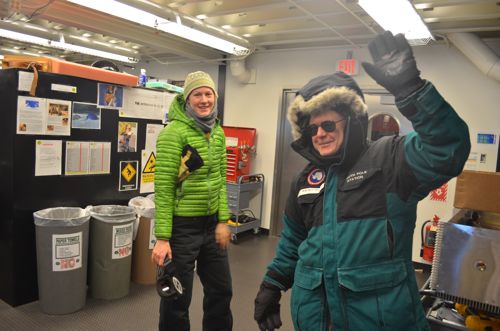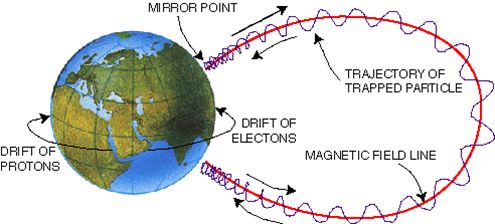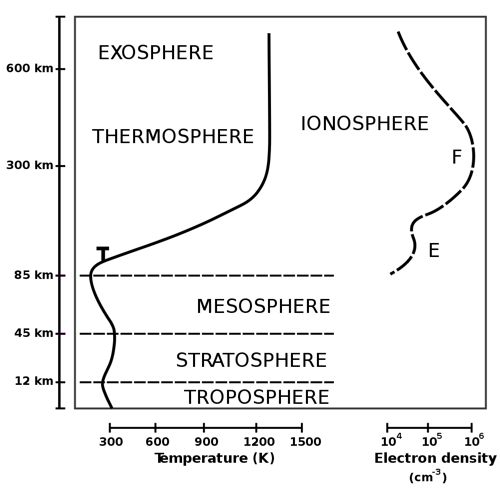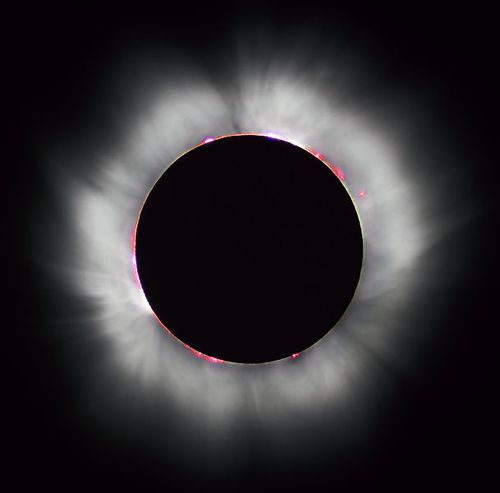Flight Update
Things are looking up! The weather has cleared and a new plan will hopefully allow Susan, Bob and me to fly out to AGO 4 tomorrow, and then Andy will join us with the cargo a day later. My fingers are crossed!
 Bob and Susan are geared up and ready to re-shuffle cargo so they are ready for tomorrow's flight.
Bob and Susan are geared up and ready to re-shuffle cargo so they are ready for tomorrow's flight.
Why I Am Here
I am here to work with Bob and Andy at the AGO sites. The AGOs are Automated Geophysical Observatories that record information about space weather. For the next few journals I will be explaining what we are doing and the instruments that are installed at the AGO site.
Why study space weather?
Although one may think the weather in space doesn't affect us, it does! The radiation and energy coming from space affects our magnetic field, which in turn affects electricity here on Earth among other things.
 This diagram illustrates how space weather affects us on Earth. Diagram courtesy of L. Lanzerotti, Bell Laboratories.
This diagram illustrates how space weather affects us on Earth. Diagram courtesy of L. Lanzerotti, Bell Laboratories.
Our AGOs as well as other space weather monitoring teams at the South Pole record how the magnetic field and ionosphere changes. This is valuable because it provides information that can be used to create a computer model of the ionosphere and space weather. It also allows scientists to make short-term space weather predictions and can provide information if there is a large solar event which could wipe out satellites and other infrastructures that we depend on.
Why study space weather in Antarctica?
The AGO team studies space weather in Antarctica because it is close to the magnetic South Pole. The magnetic field lines are vertical at the poles, which pull the particles from space close to Earth. The fact that the magnetic field and charged particles are so close makes it a great place to study space weather. The North Magnetic Pole also has the same affect. In fact, an event seen in the south is often seen at the correlating point in the north, this is called the conjugate location. For this reason, the AGO team has strategically placed monitoring stations along matching points of the magnetic field in the north and south. There are 6 AGOs in Antarctica, and a few monitoring stations in the north (ex: Canada and Greenland). Having simultaneous access to both touch down ends of the same magnetic field line is extremely valuable for space weather research. Scientists can make sure they are seeing the same event in the north and south by using accurate time stamps.
 Space weather events on one side of the Earth also occur on the opposite (mirrored) side of the Earth.
Space weather events on one side of the Earth also occur on the opposite (mirrored) side of the Earth.
 Data shows how a solar event at the South Pole station is also seen at the same time in the opposite, conjugate station at Iqaluit. Photo courtesy of Bob Melville.
Data shows how a solar event at the South Pole station is also seen at the same time in the opposite, conjugate station at Iqaluit. Photo courtesy of Bob Melville.
What is Space Weather?
Space weather is the weather between the sun and the earth that affects the ionosphere.
The ionosphere
The ionosphere is part of the upper atmosphere, which stretches from 50 km to the outer limits of the atmosphere (at 1000 km). It is called the ionosphere because it is composed of electrons and charged molecules and atoms (called ions). Ions are atoms that have an unbalanced number of protons and electrons, resulting in a positive or negative charge.
 The ionosphere is in the upper section of the atmosphere and has a higher temperature and more electrons than in the lower atosphere. Diagram courtesy of Bhamer.
The ionosphere is in the upper section of the atmosphere and has a higher temperature and more electrons than in the lower atosphere. Diagram courtesy of Bhamer.
Atoms and molecules in the ionosphere become charged because of incoming energy from the sun. Solar radiation from the sun is so energetic as it enters the ionosphere of the Earth that it knocks out electrons from the atoms there. This creates positively charged ions and free electrons. Higher in the ionosphere, these ions and electrons stay separated longer, since they are further apart. In the lower regions of the ionosphere, the electrons rejoin the positively charged ions more frequently, since they are closer together.
The Sun
Parts of the ionosphere change as they face towards and away from the sun. The part of the ionosphere that is facing the sun will have more ionization, while the part of the ionosphere that is in the dark will have less. Thus, ionization changes every day and night. Ionization also changes with the seasons. Right now the southern hemisphere is tilted toward the sun, so it has a greater ionization than the northern hemisphere. All of these charged particles in the ionosphere can even create electric currents.
 An electric current can form on the side of the ionosphere that faces the sun. Picture courtesy of USGS.
An electric current can form on the side of the ionosphere that faces the sun. Picture courtesy of USGS.
Solar Wind
A lot of the energy escapes from the sun through solar wind. Solar wind is a stream of charged particles that are emitted from the outer layer of the sun, called the corona.
 A solar eclipse allows the sun's corona to become visible. Photo courtesy of Luc Viatour, www.Lucnix.be
A solar eclipse allows the sun's corona to become visible. Photo courtesy of Luc Viatour, www.Lucnix.be
In the corona, particles are heated to over a million degrees Celsius forming plasma. Particles that have enough velocity (over 400 km/s) are able to escape the sun's gravitational field and flow outwards as solar wind. There are two types of solar wind: slow wind which comes from the sun's equator at a speed of 400 km/s, and fast wind which funnels through coronal holes at the sun's magnetic field at speeds of 750 km/s.
Coronal Mass Ejections
Coronal mass ejections or CME (commonly called solar or space storms) emit large bursts of protons and electrons into space. It is these events that can greatly affect the Earth's magnetic field.
You can see a video of a CME here
A coronal mass ejection creates a storm in the Earth's magnetic field. Compass needles can change as well as electrical currents inside the Earth. These solar storms can also create aurora by pushing protons and electrons into the Earth's atmosphere, where they are pulled by the Earth's magnetic field and collide with oxygen and nitrogen atoms. During this collision, electrons are excited or jump to different levels within the atoms, emitting photons of light. We see these lights as green or brownish red (if they come mostly from the oxygen atoms) or blue or red (if they come from the nitrogen atoms.) Green is the most common color in auroras.
 A green aurora in New Zealand is caused by solar wind interacting with the magnetic field. Photo courtesy of Paul Moss.
A green aurora in New Zealand is caused by solar wind interacting with the magnetic field. Photo courtesy of Paul Moss.
The magnetic field
A major way space weather affects the Earth is by changing the magnetic field. The magnetic field is created in the core of the Earth. The outer core is composed of molten iron, which moves inside the core in a current. The movement of the iron is what creates the Earth's magnetic field. The field surrounds the Earth, buffering it from harmful radiation. It enters and exits the Earth at the poles, which slowly wander over time. The magnetic field fluctuates because of interactions with the solar wind as well as changes in the core.
Questions
Do you think it is important to study space weather? Why or why not?
Why do you think we have less AGO stations near the Northern Pole? How is the Arctic different from the Antarctic?
Math Connection
If the ionosphere ranges from 50 - 1000 km outwards, how many miles is that? (Hint: 1 mile = 0.62 km).
If the distance between the sun and the Earth is 93,000,000 miles away, how long would it take a slow solar wind to reach the Earth? (Hint: remember to convert miles to km!) How long would it take a fast solar wind to reach the Earth?
Geography Connection
There is a space weather station at the South Pole and a conjugate (matching) location in Iqualit. Where should you look to find Iqualit? What is the latitude and longitude?
